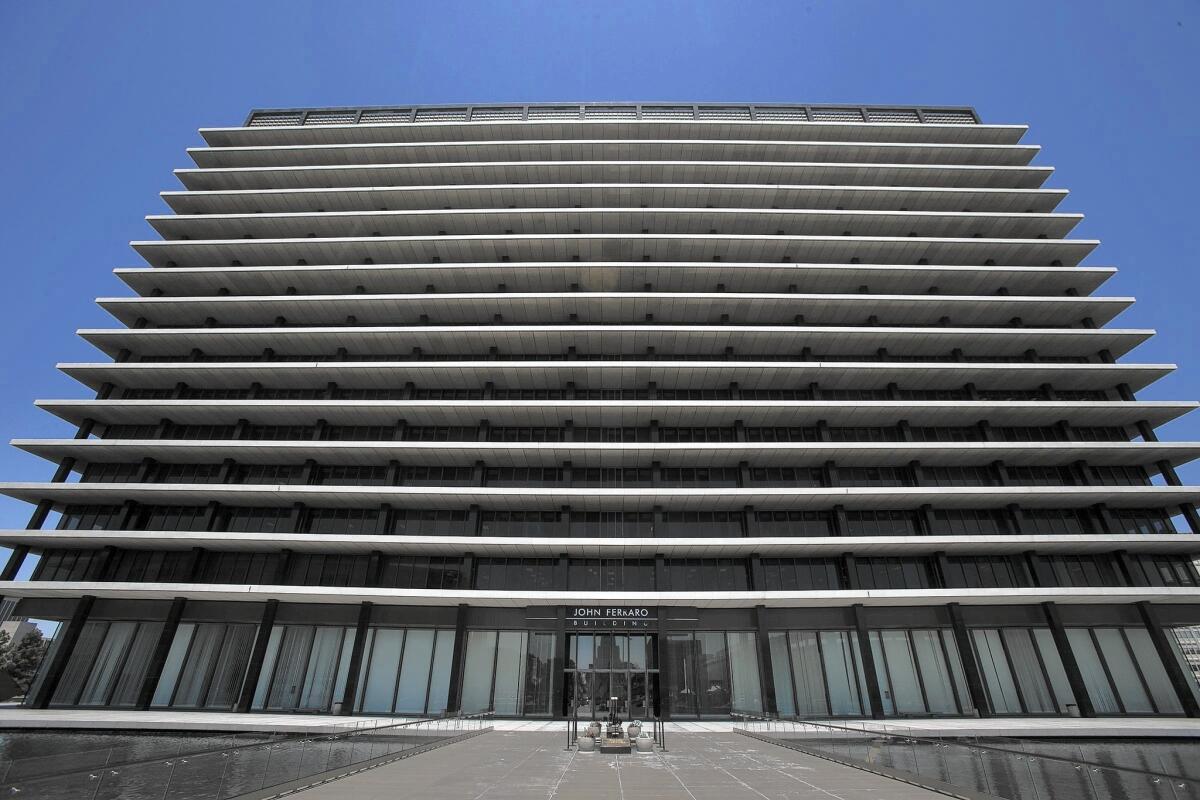L.A.’s general fund stands to gain from proposed DWP rate hikes

- Share via
Officials have argued that a series of increases in Los Angeles water and power rates are needed to improve the city’s crumbling water pipes and aging utility poles and to boost water conservation.
But the proposed hikes in Department of Water and Power bills could have another beneficiary as well: L.A.’s annual budget for general spending, which could climb more than $100 million if the City Council signs off on the five-year package of increases.
By 2020, the utility could provide an extra $108 million per year for the general operating budget, which pays for police, firefighters and other basic services, according to projections provided by DWP officials. That’s because the agency’s power division generates both utility taxes and a yearly payment to City Hall that officials describe as a DWP surplus.
The DWP, whose finances are considered separate from general city operations, has requested the higher rates to help it comply with requirements to shift to renewable energy and address a formidable infrastructure backlog, such as the replacement of power poles and transformers. But indirectly, the increases would provide Mayor Eric Garcetti and the council with added income to spend on a wide range of non-DWP programs and services.
Representatives of Garcetti and the DWP said the push for higher electrical rates is motivated by issues facing the utility, not the demands of the city budget.
“Our proposed power rate increase is driven by the need to invest in the replacement of aging infrastructure and continue transforming our city’s energy supply … as well as to expand energy efficiency programs to help our customers reduce their energy use and save money,” DWP spokesman Joe Ramallo said in an email.
Much of the budget windfall could come from the DWP’s yearly payment to City Hall, which reached $266 million last year. If the rate hikes go into effect, it could grow to $327 million by 2019-2020, assuming the current 8% transfer of electrical operating revenue continues.
DWP officials say that without the rate increases the transfer to the city general fund would grow more slowly, reaching $279 million in 2020.
City officials have long defended the transfer, saying it’s a benefit of having a publicly owned utility. But some ratepayers have filed legal challenges over the practice, saying that raising rates, and then transferring some of that money to pay for basic services, violates state law.
Richard Close, president of the Sherman Oaks Homeowners Assn., said residential ratepayers already pay City Hall a 10% tax on electricity. If they are forced to absorb higher rates, the DWP should stop declaring it has extra money to shift to the city budget, he said.
The yearly DWP transfer payment is “just a fake tax,” he said.
The city’s general fund budget is $5.4 billion. For years, mayors and council members have struggled to pare down a structural budget deficit and free up funds for initiatives such as sidewalk repairs and cuts in business taxes.
DWP officials are hoping for a council vote on the proposed water and power rate hikes in December, which would allow the increases to take effect in January. They are seeking to boost the typical household power bill by an average of 3% each year for five years and typical household water rates by an average of 3.8% each year over the same period.
Operating revenue transferred to the city’s general fund budget comes exclusively from the DWP’s electrical side.
How long those payments can continue is a legal question now before the courts. Ratepayer advocates have filed multiple lawsuits arguing the transfer payments to City Hall violate Proposition 26, a voter-approved 2010 state ballot measure that prohibits government agencies from charging more for certain services than they cost to provide. Attorney Walt McNeill, who represents the plaintiffs in one of those cases, said any DWP rate hike would likely be added to the lawsuits.
If the transfer of funds to the city budget is struck down, officials could be forced to repay more than a billion dollars to the DWP, McNeill said. “I guarantee you it’s going to be painful for them to cope with that,” he said.
City Administrative Officer Miguel Santana, a high-level budget official, said his office is not counting on any of the money that could be produced by an electric rate hike. He defended the concept of the DWP transfer, saying it makes up less than 5% of the city’s general budget and is “part of the return on investment that ratepayers experience.”
“It goes … to provide services that all Angelenos rely on,” he said.
Jack Humphreville, a frequent critic of DWP decisions, said the utility’s current rate hike proposal is appropriate. But the transfers to the city budget, he said, have deprived the utility of money needed to maintain and upgrade its operations.
MORE ON DWP:
DWP nonprofits slow to make reforms called for in city audit
DWP official on rate hikes, ‘Chinatown’ and toilet water
Steve Lopez: DWP complaints keep pouring in
More to Read
Sign up for Essential California
The most important California stories and recommendations in your inbox every morning.
You may occasionally receive promotional content from the Los Angeles Times.










